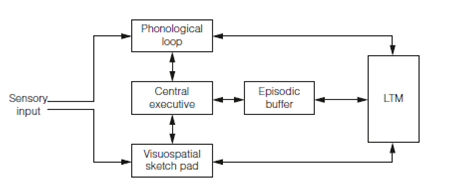Working memory
WM (Working memory) is an on-line memory system. It is used, for instance, to carry a novel phone number through it is dialed. On average humans can hold up to four items concurrently in Working Memory, by there are individual differences. Brain imaging, EEG, and behavioral studies all suggest in which the number of items which can be held is unaffected through the complexity of the items. Therefore, the capacity of Working Memory seems to be defined through the number of items rather than the total quantity of information. This supports the discrete resource model of Working Memory which argues that any item represented in Working Memory must be assigned to one of a limited number of slots. It contrasts with the flexible resource model that each item is assigned a share of Working Memory resources and which performance is limited for large numbers of items because each item gets only a small share of Working Memory resources. Interference can occur among representations held in Working Memory. If items to be remembered are same to those being processed, accuracy of recall is reduced. Delaying recall has little effect on recall accuracy so an easily decay model, in that item storage in Working Memory fades over time cannot be the case.
Working Memory capacity is absolutely correlated with several complex cognitive skills: for instance problem-solving ability, reading comprehension, maintaining attention in the face of distractions.Brain imaging and lesion studies imply the existence of several independent subsystems for working memory in figure. The phonological loop allows speech sounds to be held and rehearsed for long enough to give continuity to spoken language so which phrases and sentences can be comprehended. It needs the left cerebral hemisphere.
The visuospatial sketch pad is a provisional store for spatial, visual and kinesthetic input which brain imaging indicates includes various regions in the right hemisphere. The visuospatial sketchpad and phonological loop are together referred to as slave systems. An episodic buffer is proposed as a temporary interface among the slave systems and LTM by the central executive that binds information from a variety of sources into coherent episodes. The contents of the episodic buffer are assumed to be consciously retrievable by activity of the central executive. The executive is also postulated to mediate directed attention that transfers information into the episodic buffer from the slave systems and LTM where it can used to establish new cognitive representations and for problem solving. The central executive may plan how to execute complex cognitive activities.

Figure: Model of working memory.